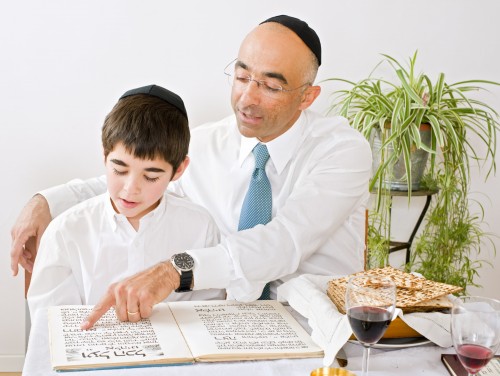
Including your children in your Passover celebrations is a piece of cake. Well, it’s a piece of Passover sponge cake, anyway! From the holiday’s oldest traditions to its newest ones, Passover’s observances place children at the center.
Jews celebrate Passover to commemorate the Hebrews’ escape from enslavement in Egypt. When Pharaoh freed the Hebrews, it is said that they left in such a hurry that they couldn’t wait for bread to rise, which is why Jews eat only unleavened bread during the holiday.
Children can be part of your housecleaning and purchasing special food, planning the seder meal and getting excited about visiting relatives before Passover even starts. They’ll probably enjoy cleaning the fridge more than you do!
There’s a ritual on the night before the seder called “bedikat chametz,” or checking for leavened food, which is just right for little kids. You hide several big pieces of bread in obvious places and then the family troops through the house with a feather and candle, hunting them. The ritual and its blessings are in the first pages of most Passover haggadot.
Another very old tradition for children on Passover is the youngest child reciting the “Four Questions.” If you know the Four Questions yourself, don’t hesitate to start teaching them to your very small child. The tune will embed itself in his or her brain and stay there from year to year, even before he or she is ready to sing them at the seder.
You can also teach your child to sing some of the shorter seder songs, like “Dayenu.” If you aren’t familiar with these yourself, you can find recordings of the songs online. For example, Craig Taubman has produced a CD called “Celebrate Passover,” which has many of the traditional songs, only a little jazzed up.
The way the hagaddah tells the story of the Exodus from Egypt worked well for previous generations that were accustomed to studying with lots of commentary, but our generation might need a little help. You can use children’s picture books to tell the story of the Exodus, either before the holiday to get ready or in place of the more traditional texts at your seder. Last year, we enjoyed using “Nachshon, Who Was Afraid to Swim” by Deborah Bodin Cohen at our second-night seder. Another book we used was “The Bible from Alef to Tav” by Penina Adelman.
The hagaddah isn’t only the story of the Exodus, but of previous seders. Tell your family stories about previous seders and stories of liberation–of coming to America, or becoming free in other ways. Don’t hesitate to include your non-Jewish relatives’ stories. The other name for the story of Exodus is “Shemot”–names–and we should speak all of their names to our children.
When I was a child, we didn’t get toys to represent the 10 plagues, but that’s been a part of my son’s holiday every year. He loves to stack the frogs! We pick up new rituals every year from scholarly haggadot that collect traditions from different Jewish communities. There are also new versions of the old Passover songs in English, or you can include songs from other traditions, like “Go Down Moses,” to make the seder feel more accessible to everyone there.
For a comprehensive Passover resource guide, visit InterfaithFamily.com.
Ruth Abrams is a Jewish writer, mother and freelance editor with a largely decorative Ph.D. who knows a lot of recipes. She blogs at theversatilewriter.org.
This post has been contributed by a third party. The opinions, facts and any media content are presented solely by the author, and JewishBoston assumes no responsibility for them. Want to add your voice to the conversation? Publish your own post here. MORE
